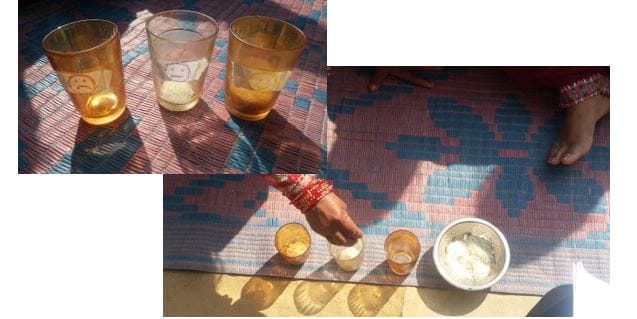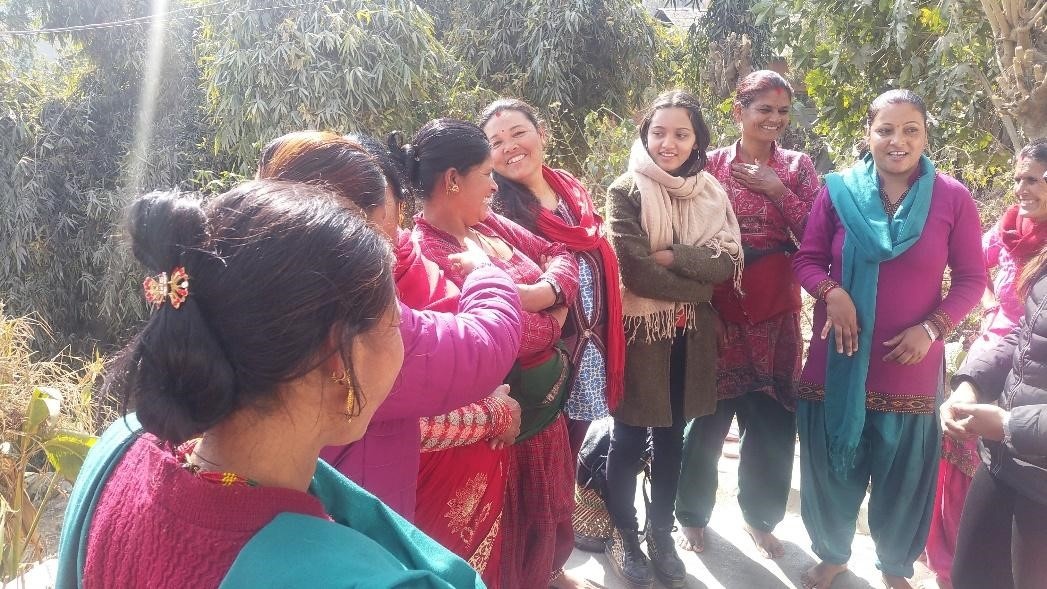Location: Khartithok (Kavresthali) & Thumki (Jitpurfedi)
Dates: 21 January 2019 (Thumki) & 31 January 2019 (Khartithok)
Workshop delivered by Patricia Iacob and Chiara Caminiti (EU Aid Volunteers on gender issues) with the help of Razni Karki (local volunteer).
Text by Patricia Iacob and Chiara Caminiti
Photo credit: Patricia Iacob
After having raised awareness on domestic violence and the importance of identity and self-esteem in rural women’s lives, third on the life-skills agenda was communication and expression of oneself in public.
This was a challenge theme to work with, especially with these groups of rural women that never payed attention to or even conceived of this issue. We had to create practical tools to reach them and increase the interest within the groups. Even though the activities we engaged women in could prove, to the trained and expert Western eye, rather simple, superficial or even pointless, our focus was on raising awareness on the processes that lie in the background of communication, at its most basic. In this sense, we worked extensively on their feedback, the attention paid to the other but also to the process of communication itself from the sender to the receiver. This allowed us to notice improvements during the workshop, from the very first presentation (which found the women rather inattentive and taking pains at describing the other) to the last round of activities (which revealed a more engaged presence of the women, who delivered information more accurately thanks to a clearer idea of effective communication).
Structure and findings
1. Presentation Circle Dynamic
Instead of the usual individual presentation to the group, the women stood up and formed couples within which they presented themselves. Other than their names and occupation, they exchanged about their lives and preferences such as food, hobbies, colours, music, dance, etc. Subsequently, a circle was formed and each participant presented their pair to the group. The effort to deliver a

presentation of the other as faithfully as possible generated rounds of laughs. The women drew closer together and were ready to give their feedback. With large smiles, they expressed their happiness after that simple exercise. Taking a moment to listen to the other, finding out details about their lives which normally they are too busy to share, fostered a sense of connection and light-heartedness into them.
To keep up the enthusiasm that the previous exercise sparked in women, we engaged them further by a brainstorming exercise. They were stimulated to reflect on the main theme by replying to questions like “what is communication?”, “can you find an example of communication?”, and “what happens when we communicate?”
2. What is communication
What is communication? The first reply, and to our surprise, a unanimous one, was… “facebook”. Modern means of communication are entering these women’s lives, unfortunately without cultural and educational filters, risking to foster wrong (and long-term harmful) ideas about what real communication is. As to the whys, women valued communication’s importance to share feelings, give and take help from friends, take and give suggestions, for economic help, and to go shopping. Their own pieces of advice for better communication revolved around the use of a commanding, harsh voice, a normal voice, or a dominating, angry voice.
After this short brainstorming exercise, the facilitator presented to them the three types of communication, that is, aggressive, assertive and passive. The local volunteer read out three relevant examples to ease the understanding process of the respective forms of communication. These dialogues, anchored in the daily life of a Nepalese rural woman, were a good way to make them realise the importance of assertive communication.

3. Role play
To put the previous activity into practice, the women were called to recall a situation where communication played a key role, such as an argument, a misunderstanding. The facilitator brought them back to the dialogue exemplifying the various types of communication. The women were then asked to turn aggressive communication into assertive one. Yet again, spirits uplifted and the women proved interested and surprisingly resourceful.
4. Expressing oneself in public
Even if rural women may never be exposed to the challenge of doing a public presentation, they still need to communicate information to an audience, be it their family, the group of women they regularly join, or any other group they could find themselves in at any given moment in their lives. This is why expressing oneself in public is a much-needed skill. Especially for rural women, developing such a skill could boost their self-confidence and open up opportunities, allowing them to make a difference in their business, their community and the world at large.
This time we resorted to a very mundane activity, such as tooth brushing. One woman was chosen to describe this activity in as many details as possible, while the facilitator reproduced it with fidelity.

All participants were encouraged to contribute with acts that might have been missed so that the brushing act was complete. The round of laughs fed the observations on the importance of having a clearly-delivered and well-structured message while communicating with the others. Alternatively, we added another example, again recalling women their daily routines. It was daal bhat’s turn to be communicated. The women shared all the preparation and cooking steps with precision but were rather challenged when we asked them to think of creative ways to sell the product as a group.
5. Evaluation and ending circle
In order to have a more concrete feedback on the activities, the workshop ended with an evaluation with smiles. Three small glasses were put in front of the women, each one of them with a smiley drew on it which expressed contentment, neutrality, and discontent. With the help of local rice grains, women voted by placing them in the corresponding glasses. The session was mainly perceived as useful and good, but there were also women who thought that there was room for improvement. The workshop did not leave anyone discontent.

Observations and conclusions:
As usual with our workshops, the main difficulties we encounter lie with the location. Outdoor conditions are improper to form the circle of trust, a very much needed feature that ensures a smooth running of the event, continuity and, ultimately, the efficiency of our efforts. Women are too often distracted by passers-by, usually other village women, children or men requiring their undivided attention and presence at the regular chores, such as cooking and tending to others’ immediate needs.
Attendance is also inconsistent. Women keep coming and going. In one location, for example, from the 11 present at first, only 7 stayed and the workshop ended with 9 women. Brief presence cannot transmit the entire knowledge and tools we seek to foster into them. However, we rest assured that even a few minutes of attendance can spark some sense of awareness into them and that tiny seeds of change are being sowed. Bistarai, bistarai, how Nepalese use to refer to the slow rhythm of their daily lives.


